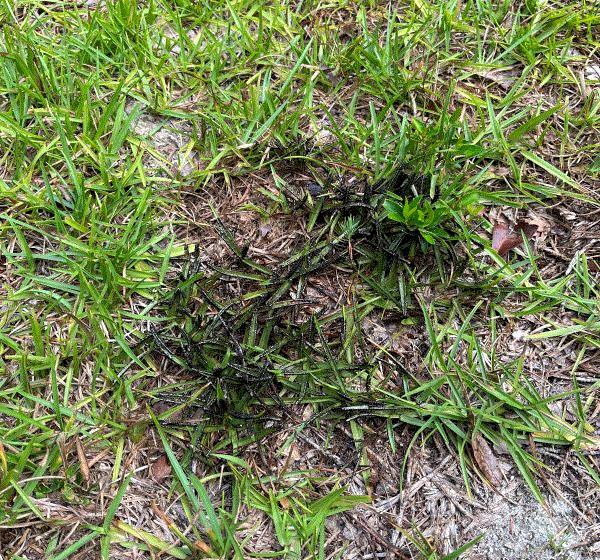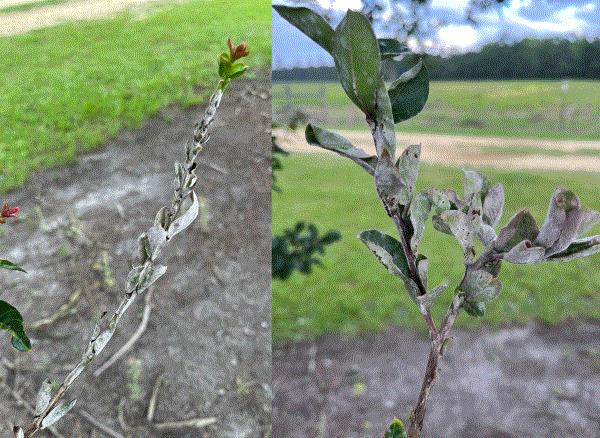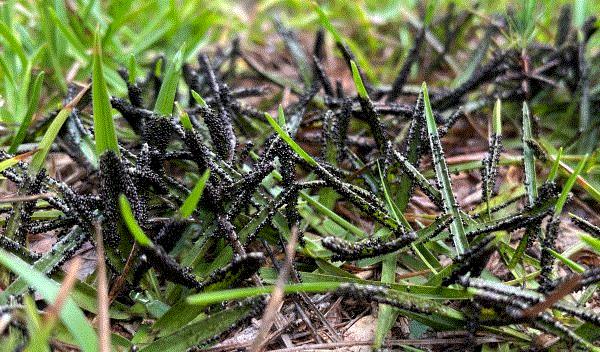What the ... ?
I hope everyone enjoyed the Independence Day holiday. It was a hot and sweaty one in South Carolina. The oppressive heat and humidity, gnats in my eyes, and no-see-ums in my hair made for an unpleasant week. As a consolation, I ate enough sausage and brisket to make up for all my problems.
Heat and humidity brought out lots of different diseases. Powdery mildew is rampant on crape myrtles at my old office. I also found something interesting in my so-called lawn, which showed up overnight. (How can a turf and ornamental entomologist not able to keep a nice lawn, you ask? That’s easy! Give it a little shade, not a lot of mowing, a dash of belief in the ecological power of a mixed-species lawn and voilà!)

Back to the interesting creature ... I found this black patch on centipedegrass with what looks like greasy fungal growth and lots of large, black, shiny sporangia on grass blades. A fungal disease? What do you think the black patch may be?
Powdery Mildew on Crape Myrtles
Powdery mildew is quite host specific. The powdery mildew on crape myrtles won’t infect the squashes in my garden and those on the squashes won’t jump over to infect my tomatoes. While each species has its unique host preference, the conditions and management of powdery mildew are somewhat similar among species.
The risk of powdery mildew outbreak increases in lock step with humidity. While the ranges of relative humidity and temperature most suitable for spore germination and infection differ among powdery mildew species, conditions that favor an outbreak of most species are extended periods of high relative humidity at night and moderate temperatures. Different from other fungi, free water on leaf surfaces actually prevents powdery mildew spore germination. Knowing the optimal conditions helps to determine when management strategies need to be in place to prevent spore germination and infection.
It doesn’t matter whether the powdery mildew occurs in the landscape or greenhouse, on ornamentals or vegetables, I think plant species and cultivar selection is the critical first step in preventing outbreak. After growing plants for a few years, you’ll have a pretty good list of what are very susceptible to powdery mildew. On my list are crape myrtles, dahlia, gerbera daisy, rose and zinnia. I keep a close eye on these plants and treat them preventively when the conditions are right for infection.
The availability of powdery mildew-resistant crape myrtle cultivars is a rare example of plant breeders taking pest and disease resistance seriously when selecting new cultivars. Click HERE for a list of powdery mildew-resistant crape myrtle cultivars.

Good air circulation and sun help reduce humidity, so ventilation at night in greenhouse and plant-susceptible species, such as crape myrtles, in open areas will help prevent powdery mildew outbreaks. But strong air movement can also move powdery mildew spores around in greenhouses, so plan carefully.
I often see powdery mildew infection on the new growth of crape myrtles. That points to a second characteristic of powdery mildew outbreak, i.e., infection is aided by the presence of tender, soft new growth. Excessive nitrogen fertilization that promotes succulent growth should be avoided. Nutritionally stressed plants are also more susceptible to powdery mildew, so a key to preventing powdery mildew outbreaks is to provide plants with a balanced fertility program. There's evidence that silica sprays help reduce powdery mildew infection, but I think stronger evidence, specifically for ornamental plants, is needed.
Sometimes, everything we do culturally can't help with preventing an outbreak. I think powdery mildew is one of the easiest diseases to manage with fungicide. Whether you're dealing with them in the landscape, nursery or greenhouse, there are quite a few effective fungicides of many modes of action (denoted as Fungicide Resistance Action Committee or FRAC group) to choose from.
FRAC Group 3 (e.g., propiconazole, myclobutanil and tebuconazole), 5 (piperalin), 11 (e.g., azoxystrobin, pyraclostrobin, trifloxystrobin and other FRAC 7 + 11 premixes), M1 (copper compounds), and M5 (chlorothalonil) are very effective options. I even got powdery mildew under control with a mixture of baking powder and soap in my research greenhouse. The key to successful management is to make the fungicide application during the optimal conditions for infection or before symptoms appear. These fungicides can’t cure the distortion caused by powdery mildew, but they can prevent infection and further damage.

Efficacy Summary for Scale Insects
IR-4 updated its scale insect efficacy summary last week. Scale insects and mealybugs were identified as research priorities for the IR-4 Environmental Horticulture Program in the 2021 workshop. New research data gathered in 2021 and 2022 are included in the updated summary.
All told, 85 trials were conducted on 24 soft, armored and other scale insect species since 2003. Among the tested products, XXpire (sulfoxaflor + spinetoram), horticultural oil, Talus (buprofezin), Rycar (pyrifluquinazon), Distance (pyriproxyfen), Safari (dinotefuran) and Ventigra (afidopyropen) are the standouts. Kontos (spirotetramat), TriStar (acetamiprid), Flagship (thiamethoxam), Mainspring (cyantraniliprole) and Marathon (imidacloprid) also reduced scale insect populations.
If you read the efficacy summary closely, you’ll notice that the it emphasizes the great variation in efficacy of insecticides in managing scale insects, depending on species and application methods. I definitely agree with that conclusion.
In my experience, armored scales are more difficult to control than soft scales. There are several reasons for that, including the fact that armored scales are better protected by their shells and they generally have more generations per year (thus more crawler emergence times and more sprays). Armored scales feeding on woody tissues, such as trunks and branches, are harder to kill with systemic insecticides than those feeding on leaves—likely because systemic insecticides concentrate in the leaves, but not the trunks or branches. Armored scales also feed on cells individually instead of phloem, where systemic insecticides are carried at a higher dose.

Can you see the scales?
For many of the above reasons, the efficacy of systemic insecticides (applied as drench, basal trunk spray, injection or granular broadcast) is quite low against armored and soft scales that are feeding on woody tissues. The same insecticides can be quite effective against scale insect species that feed on leaves.
For species that feed on woody tissues, I recommend spraying horticultural oil, a tank mix of horticultural and Talus, or a tank mix of horticultural oil and Distance at the time of crawler emergence. It’s critical to spray to target crawlers or hatchlings because these little guys aren’t covered by wax or shell and easy to kill. You can figure out when eggs may be hatching if you know the scale insect species or use a sticky trap to monitor (simply by wrapping a tape, sticky side out, on a twig like the picture above).
Can’t get enough of what I think about managing mealybugs and scale insects? Click HERE for an article I contributed to the 2022 GrowerTalks Insecticide, Miticide & Fungicide Guide.
Also, tell IR-4 what’s bugging you in this survey. Results of this survey will determine the direction IR-4 research efforts will take in 2024 and 2025 during the workshop scheduled for October. So if you really hate mealybugs and scale insects, tell IR-4 how much you hate them in the survey. The deadline for submitting the survey (online or by mail) is September 1.

AFE Awards Research Grants
The American Floral Endowment (AFE) announced its 2023-2024 research grants last week. This year, AFE will provide $550,000 to support five new projects and seven continuing projects that will yield results impactful to the bottom line and sustainability of the floricultural industry.
The funded projects are:
-
Use of CRISPR to develop powdery mildew resistance in gerbera by Dayton Wilde, the University of Georgia
-
Engineering floral fragrance to new heights using a synthetic biology approach by Thomas Colquhoun, the University of Florida
-
Development of potent ethylene antagonists for floricultural crops by Rasika Dias, the University of Texas at Arlington
-
Developing foliage stock plant, liner and finished plant production protocols for temperate climates by Roberto Lopez, Michigan State University
-
Manipulating light quantity, quality and duration to improve timing, yield and quality of cut flowers by Roberto Lopez and Caleb Spall, Michigan State University
-
Altering petunia development rate to improve cutting yield and crop production efficiency by Ryan Warner, Michigan State University
-
Identification and application of plant growth promoting bacteria to improve floriculture crop plant quality and reduce input by Michelle Jones, The Ohio State University
-
Enhancing the performance biological control agents for Botrytis control by Jim Faust, Clemson University, and Anissa Poleatewich, the University of New Hampshire
-
Optimizing the efficacy of beneficial bacteria against Botrytis blight in greenhouse crops by Michelle Jones, The Ohio State University
-
Asteraceae petal blight: Pathogen identification and methods to facilitate effective control strategies by Julia Kerrigan, Clemson University
-
Supporting the U.S. specialty cut flower industry through diagnostics, disease management and outreach by Francesca Hand, The Ohio State University
-
Can western flower thrips be managed in commercial greenhouses with UV light? By Bruce Parker, the University of Vermont
Click HERE to find out more about the funded projects and how to contribute to AFE’s research funds.

Answer to “What the … ?”
The black patch on my mixed-species lawn wasn’t a fungal disease, but a patch of slime mold. I know, I already gave the answer away in the subject line of this newsletter … that’s why I didn’t quit my day job to become a trivia master.
Slime molds are very interesting creatures. They look like fungi and produce sporangia, but despite their common name, they ain’t fungi. They’re amoeba-like and move around feeding on bacteria, but they ain’t animals. They definitely ain’t plants. They’re somewhere in between these groups, yet unique on their own. So slime molds are ... well ... slime molds.

Slime molds aren’t pathogens. They produce sporangia, which release spores into the environment. These spores germinate when conditions are just right, and the amoeba-like motile cells grow and eventually congregate in soil and thatch. The congregation, called plasmodium, is the slimy patch that covers the grass (or mulch and other surfaces). Most of the time, slime molds are deep in the thatch or soil and not noticeable. I often see a big mass after a period of rain (the week before the Fourth of July in this case) followed by a period of dryness with high humidity (week of the Fourth). The plasmodium moves up the leaf blades or other structures, produces sporangia and releases spores, starting the cycle anew. This black patch isn’t the only form I’ve seen. Bright yellow, orange and brown are common.
No management is necessary because slime molds don’t damage turf or other plants. They disappear after a few days. If you really want to do something because you're bored, you can wash or brush them off. Save your fungicides for something else.




See y’all later!

JC Chong
Technical Development Manager at SePRO
Adjunct Professor at Clemson University
This e-mail received by 27,847 subscribers like you!
If you're interested in advertising on PestTalks contact Kim Brown ASAP!